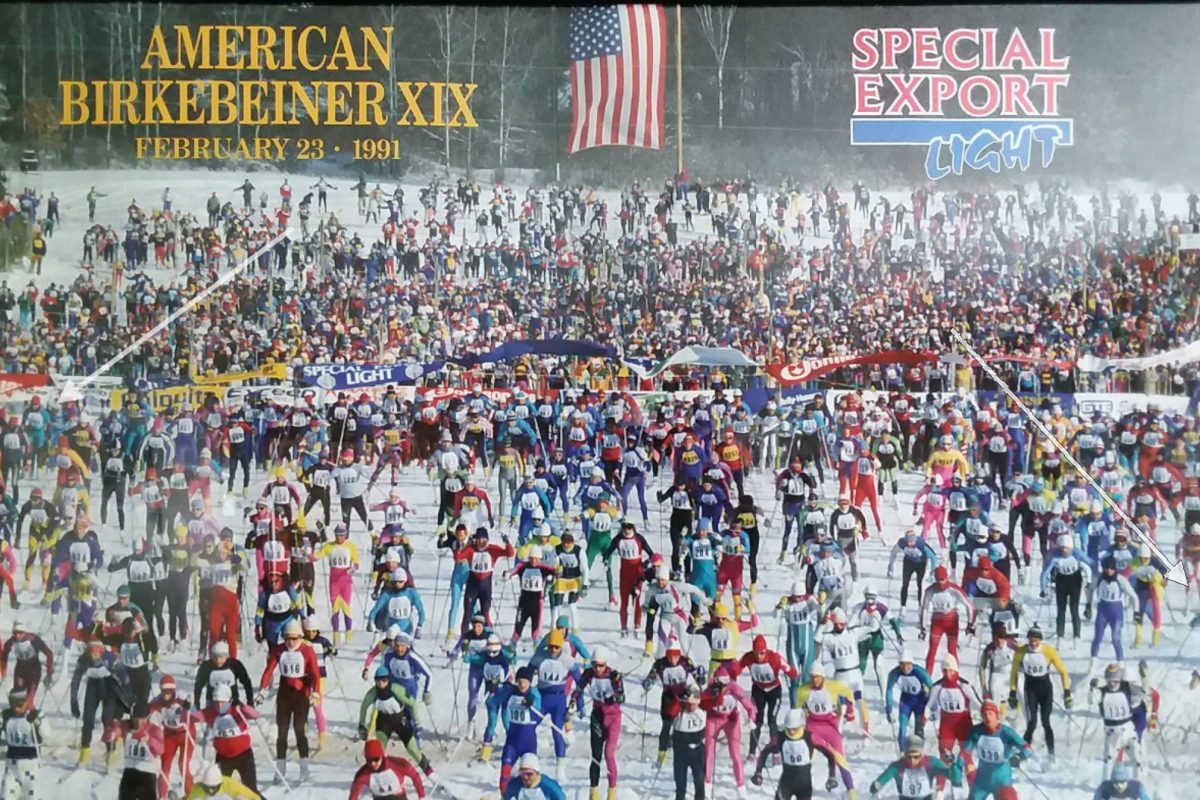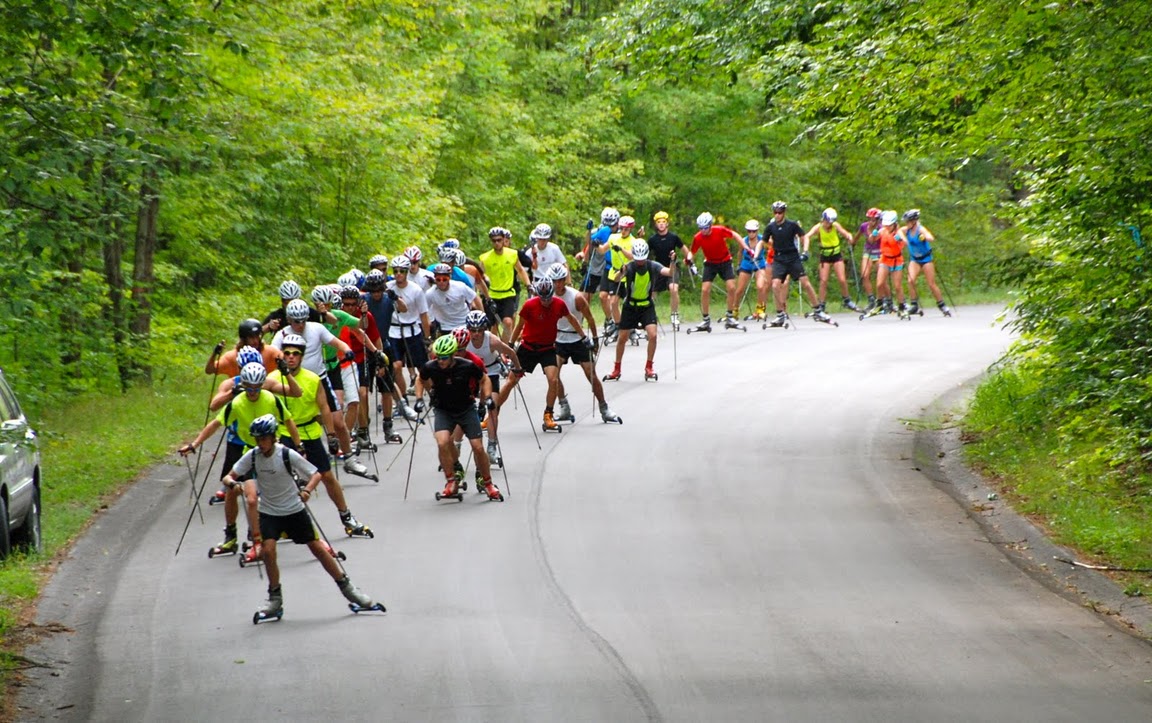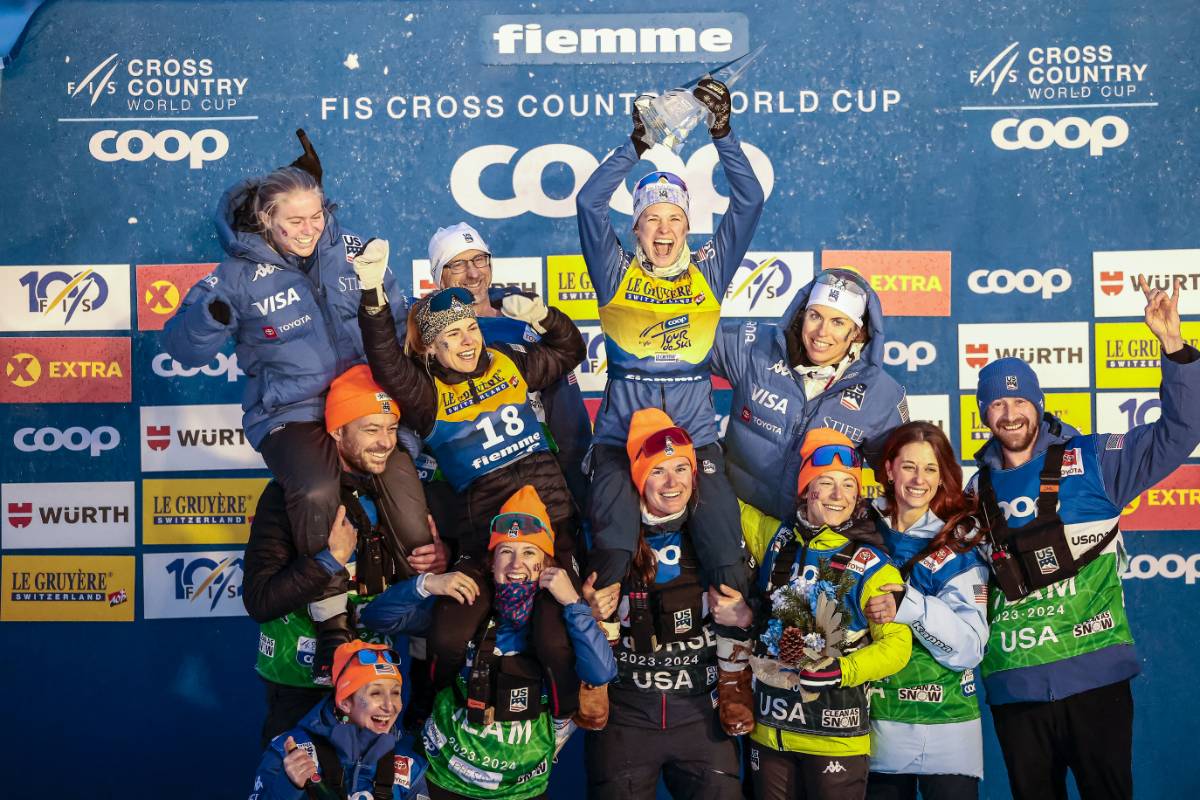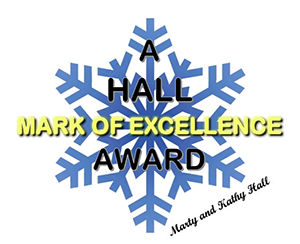 This coverage is made possible through the generous support of Marty and Kathy Hall and A Hall Mark of Excellence Award. Learn more about A Hall Mark of Excellence Award—or about supporting FasterSkier coverage—by contacting info@fasterskier.com.
This coverage is made possible through the generous support of Marty and Kathy Hall and A Hall Mark of Excellence Award. Learn more about A Hall Mark of Excellence Award—or about supporting FasterSkier coverage—by contacting info@fasterskier.com.
Rosie Brennan has been a fixture on the Stifel U.S. Ski Team for several years, weathering the ups and downs of professional athletics with grace, aplomb, and stoic professionalism. Her determination and perseverance have created scores of admiring fans, and inspired her reputation as a hard working, blue collar skier. Her standout performances make her a regular resident on the International Ski Federation (FIS) overall points chase leaderboard. The waxing and waning support of the U.S. team is far behind her now, and she is considered a team stalwart.
At age 34, Rosie Brennan is still passionate about skiing and her pursuit of skiing excellence, though she is admittedly disinterested in social media and doesn’t seek publicity. She was gracious enough to spend an extended amount of time talking to FasterSkier, speaking at length about her career struggles, goals, relationship with the media, and what her future holds. She is remarkably candid in expressing her views and offered insights into what it means to be a professional ski athlete in America. She also discussed the racing she undertook after the World Cup, racing that has received very little attention—until now. Definitely not a self-promoter, her second place and fifth place finishes in two consecutive days of racing after the World Cup season on the Ski Classics tour would have filled endless Instagram pages of other racers: not Rosie. Her decision to continue racing after the end of the World Cup season shows a level of determination that is truly next level.
This article has been edited for clarity and brevity. It is part one in a multi-part interview with Ms. Brennan.

FasterSkier: Where are you now?
Rosie Brennan: I’m in Anchorage.
FasterSkier: And you’ve been there pretty much since you got back from the World Cup season?
Rosie Brennan: I went to Bend camp and then I’ve been here since.
FasterSkier: Do you consider Anchorage home now?
Brennan: Yes.
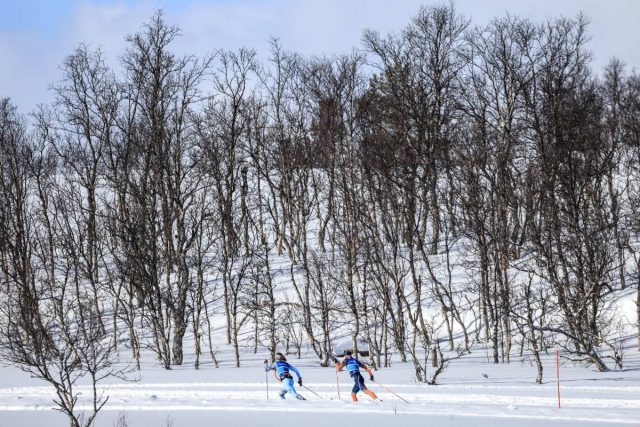
FasterSkier: I want to pick up at the end of the last World Cup season. It didn’t get very much press domestically, but after the World Cup season was over you raced two of the Ski Classics races. You did the Reistadlopet (40 kilometer classic race) and the next day the Summit 2 Senja (68 kilometer classic race) which are back-to-back Saturday and Sunday marathons. You had great finishes, second and fifth place respectively. That had to make you feel quite good coming off of the grueling World Cup season?
Rosie Brennan: Yeah, I was happy about the races. It was a really cool experience and a lot of fun, so I really enjoyed it.

FasterSkier: What prompted you, after the end of a grueling World Cup season, to do these two races? Was that something you had planned at the beginning of the season, or was it simply, “I’m already here, let’s just do it?”
Rosie Brennan: That’s a great question. Definitely something that was planned. I would not have done that if you had asked me that last week in Lahti if I wanted to keep racing. I would be like, ” Hell No!” So, that was definitely a premeditated plan. But my boyfriend is Tyler Kornfield, and he was racing. He did the whole Ski Classic season last year. He was on team Robinson Trentino, which is an Italian ski Classics team and technically, I was on the team as well. I was hoping to do a few of the races just to mix things up, and challenge myself in different ways. Then our World Cup season ended up being so insane and so long that those two [Ski Classic races] were the only option. So, I decided to do those, but also I had interest because my wax tech is actually from the town where the Resitadlopet is. He had talked to me quite a lot about it, and I really wanted to go to northern Norway and see what it was about and check it out. And I knew that he would wax my skis for me (laughing). So I had that part covered.
FasterSkier: I was curious about what level of support you had for those races.
Rosie Brennan: I was part of team Robinson Trentino, so I had their support there. In terms of Ski Classics teams, they’re pretty small and underfunded compared to the Scandinavian teams, but support is support and it was still very helpful. Because both of those races are actually quite hilly, I used kick wax and so I had my wax tech do the kick on my ski. He knows me and my skis and knows how to kick wax, and he’s from there. So, his local knowledge is quite good. It all just worked out really well. It just made sense to do those races, so it was really cool.
FasterSkier: Had you made that decision before the World Cup season even started then?
Rosie Brennan: That decision was made in June last year or something. So I was fully committed.
FasterSkier: So, you were all in then?
Rosie Brennan: Yes, which I am glad of. If you tried to make that decision, even in January it probably would have been—no. But when you plan it ahead of time, then you just know, yeah, that’s my departure date from Europe, and you just kind of accept it. Then it’s not that bad. I had a ton of fun.
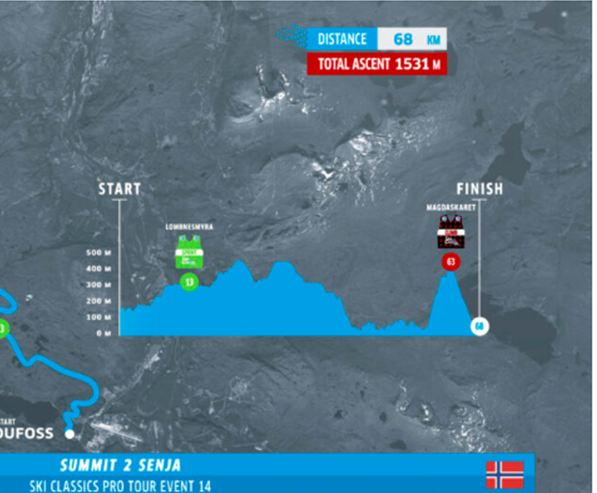
FasterSkier: Looking at the profile on the Resiadloppet, it has a crazy hill climb in it which looks every bit as steep as what you see on the hill climb at the Tour de Ski. How did that compare for you?
Rosie Brennan: It’s not quite as steep, or at least not like consistently quite as steep. There were definitely some steep pitches that you were doing herringbone, not striding. So yeah, it was really challenging, but again that was one of the reasons I picked those races. I don’t double pole half as much as those Ski Classics athletes; there’s no way I stand a prayer in a double pole race.
I was excited about the climb. That was definitely part of the intention with those races. Actually, I will say the the Summit 2 Senya one was significantly harder because it also had a huge climb and that climb came at 60K.
FasterSkier: So close to the finish?
Brennan: Yes. It was about a 5K long climb at 60K and was also very steep—like herringbone level steep—and that was insane.

FasterSkier: You came off the World Cup tour, you enter the Ski Classics and get a second place on Saturday, a fifth place on Sunday, you must have been pretty proud and pumped up about that?
Rosie Brennan: Well, by the time I finished on Sunday, I was like, where’s the bed (laughing)? I’m not going to make it any further. That was very challenging for me, but I was really proud of myself for doing it….taking that chance on myself. It was a lot of fun. I think one of the coolest parts is that it was one of the last races of the year. It was essentially just like I had already started training for the next season. It was like doing probably 5-6 hours of Level 3- level 4.
I felt like I gained a lot from doing that and then part of part of my reward was that I stayed with my boyfriend for a week after, and we went back country skiing.
FasterSkier: It’s just really impressive that you had that much gas left in the tank after the end of the World Cup season to be able to put that kind of effort in. I remember talking to one of the U.S. coaches, the Sunday of the last weekend of racing in Lahti and asked him if people were staying around to take advantage of the fact that you’re already there. The response was emphatically, “No, we’re exhausted. We’re getting on the next plane out of here and we’re going home and we’re going to bed. For a week.”
Rosie Brennan: Yeah, yeah, yeah, I know. Had Tyler, not been over there I think I would have felt that way too. I finished plenty of other seasons in that same way. But, I had made this commitment and we were doing it together so it didn’t feel that bad. But I’ve been doing the World Cup for a long time, so I kind of knew how tired I was going to be and what to expect.
FasterSkier: Having such great finishes in those two races, whenever in the future the conclusion of your World Cup racing may be, is there a future in Ski Classics for you?
Rosie Brennan: Probably not. I definitely was curious to do some of them to see what that was all about. It is a really cool circuit. But I don’t know if I’m fully captivated by the idea of only double poling. It’s a cool challenge and I understand why people are attracted to that challenge, but I’m not sure it’s the challenge I crave. Maybe I’ll change my mind, but right now it will be fun to participate in a couple of them, but I don’t know if I’m a full on Ski Classics kind of person.
FasterSkier: Next year they’ve going to have a 100K race, the Janteloppet, to end the season. Any possibilities of doing that?
Rosie Brennan: I don’t know. I’m definitely intimidated by 100K. I’ll say that much. So, it’s not like my gut reaction is, “Yeah let’s go do that.” But I haven’t really gotten that far yet to detail out what my season is going to look like and how long I’m going to stay over there and that sort of thing. So we’ll see.
FasterSkier: You were headquartered all last winter in Italy. Was that a new a new thing for you to have a home base camp during the World Cup season?
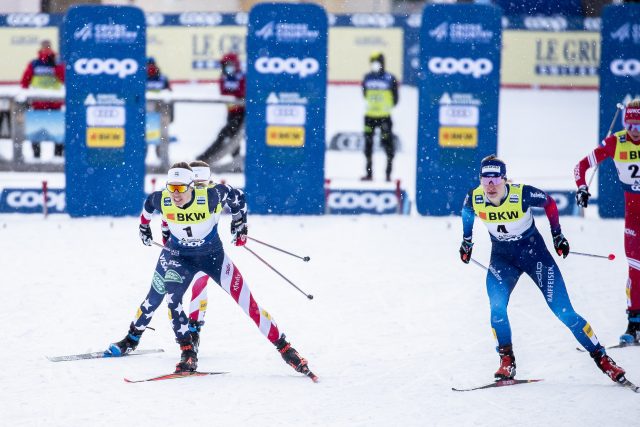
Rosie Brennan: Yes, it was. It’s something I’ve always dreamed of. Tyler, for most of his career, was bouncing back and forth between a World Cup and Super Tour and that sort of thing. So, it was just never something that we could commit to doing together, just not ever knowing where he was going to be. So, when he retired from that form of racing and decided to go into Ski Classics, it was a perfect opportunity to try it out. So, we did that last year and it was great! That’s probably one of the reasons I was able to stay and race those races [Ski Classics]. It did just take some of that home sickness and stress off of me, a little bit. It just feels more like home when you have your partner for dinner some nights and get to spend some time together. So that was a really special experience. He’s done racing completely now, so, unfortunately, I don’t think we’ll be doing that again. I’m really grateful that we got that year to do that together.
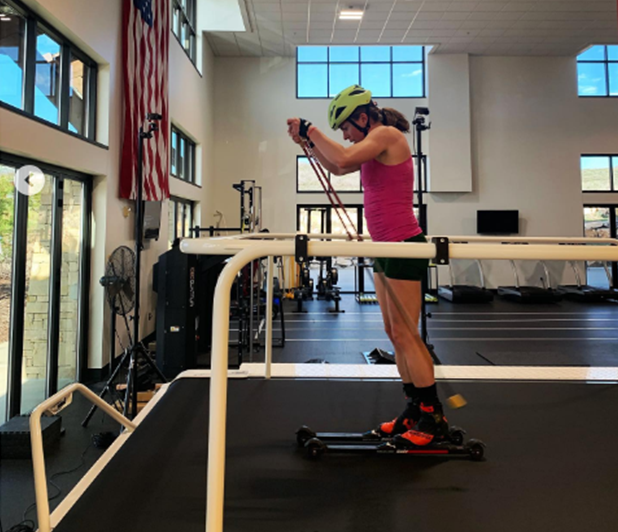
FasterSkier: When you talk to the American racers and coaches, they always talk about the disadvantage that the North American teams face by essentially being on the road for four months and not having a home base. It sounds like this really did work to your advantage. Is it something that you’ve brought up to the team coaches that maybe we should consider doing this as a team?
Rosie Brennan: Yes and no. As a team it’s pretty challenging because everyone’s needs are a little different and things like where do you go, do you go to altitude, do you go to sea level? That also changes quite a bit based on the calendar and where the races are and where the championships are and that sort of thing. I also think a big part of it is, like I said, having my partner there and having my space away from the team.
There definitely would be some advantages to having some team apartments or something like that, but I’m not sure. It’s still not the same as having your home there. After doing it last year, I probably have some regrets of not trying to do it with Sadie or somebody, that I was very close with while she was my roommate in in Anchorage, so I knew I could live with her. It’s just challenging with people’s personal lives and their partners and that kind of stuff. I think that’s truly what makes it feel a little more like home is having your people with you.
FasterSkier: And not having a giant camp of disparate personalities?
Rosie Brennan: Yeah. Yeah, exactly.
FasterSkier: On the topic of venues, I want to ask you about Davos. You always do really well in Davos and the American team seems to really do well in Davos. Can you put your finger on what is going on with Davos, which makes it so good for you and the rest of the Americans?
Rosie Brennan: That is a good question. I’m not really sure why. I do think in general we tend to do pretty well at altitude. I think just growing up in the U.S., you just have way more experience racing at altitude and honestly above the FIS limit. Because that’s just where some of our skiing is. For me, that’s especially true because I grew up at high altitude, so that feels very normal. I don’t really even bat an eye at it, but I think even for people that that grew up at sea level in the US, you still [have races at] at high altitude. So we just interface with it [altitude] a lot. More than say, a Norwegian skier does, who probably doesn’t even touch altitude until they get a World Cup start. I definitely think that’s an advantage for the Americans. And I guess our techs must be good at waxing for that kind of snow! We tend to have good skis there. We also tend to be good skaters, and it’s almost always skate there, so I think that probably helps too.
FasterSkier: It feels like it’s almost home court advantage for the US team there.
Rosie Brennan: We have spent a lot of time there too, so that probably doesn’t hurt. We’ve done a lot of training camps there and a lot of people spend the holidays there and that sort of thing. So, it is somewhere we’re pretty familiar with.


